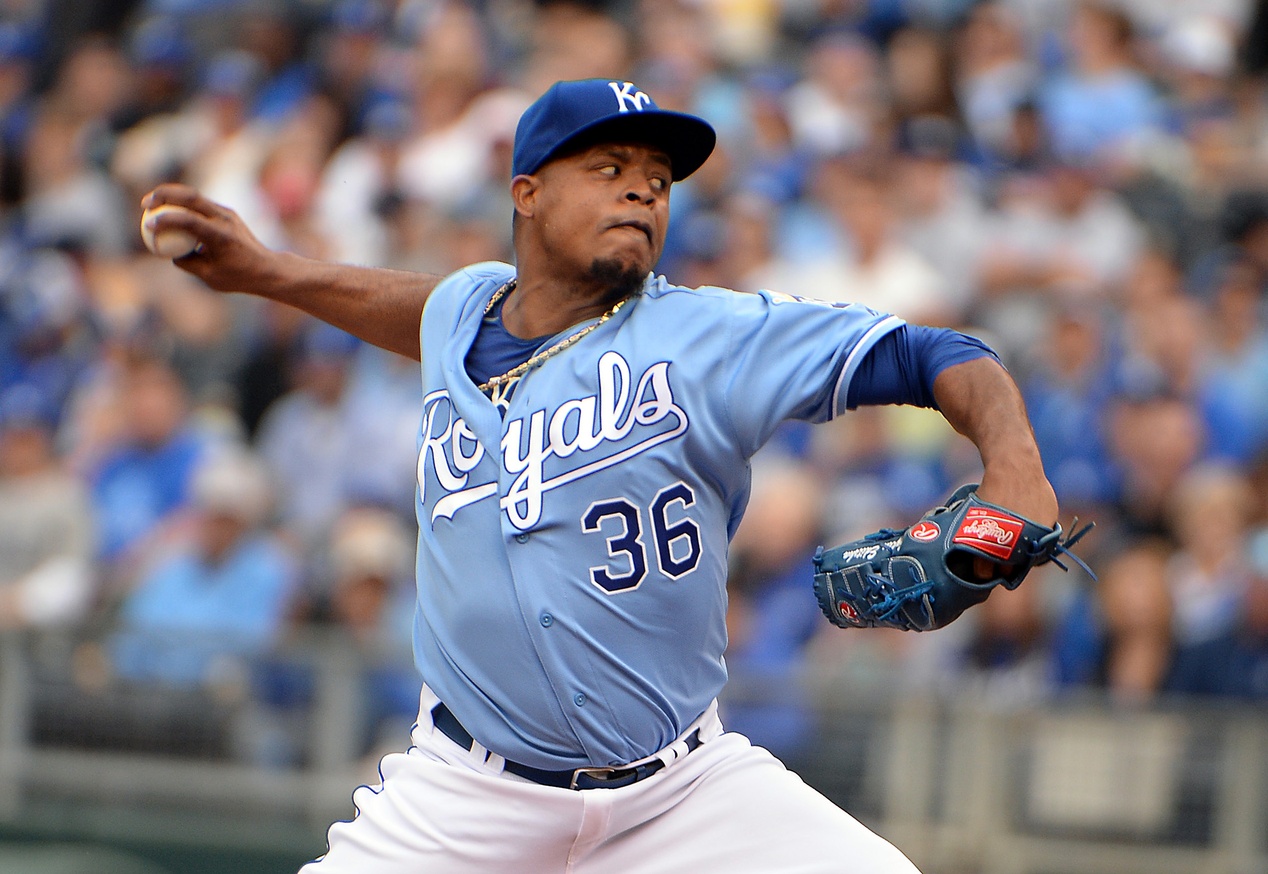For the last several years, the Royals run prevention has been centered around their defense. They have Gold Glove-caliber defenders basically all over the diamond, with eleven awards among them. The 2016 squad appears to be another excellent defensive club, but the first few games have revealed another potential way this team can prevent opponents from scoring: strikeouts.
The Royals’ bullpen obviously has some guys known for getting plenty of strikeouts, but their rotation has seemingly lacked those types of pitchers in the last several years. In fact, the last time the organization had a starter strike out more than a batter per inning was in 2009, when Zack Greinke terrorized the American League with 9.5 K/9.
Since Dayton Moore came to Kansas City, there have only been three instances of a Royals starter topping 100 innings and 8 K/9. Greinke had 8.1 per 9 in 2008, Felipe Paulino whiffed 8.7 per 9 in 2011, and Yordano Ventura ended last season with 8.6 per 9.
This isn’t a franchise recently known for having a stable of high-strikeout starting pitchers. That is, until this year.
Obviously the sample sizes are still minuscule, and obviously the opponents matter, so don’t look at this as some sweeping statement or proclamation that the Royals are going to end the season with more strikeouts than the White Sox rotation. Just consider it a notice of something to keep an eye on moving forward. Plus, a pitcher’s strikeout rate is one of the first statistics to stabilize in a season – after about 70 batters faced – so it won’t be much longer until we can start to give these numbers a bit more weight.
Thus far, the Royals’ rotation has struck out 9.8 batters per 9 innings, which is the fifth-best mark in baseball. Maybe that doesn’t surprise you, but it did surprise me. Then again, maybe it shouldn’t?
Below is a table, showing the preseason PECOTA projections of K/9 for the Royals’ rotation, along with their actual year-to-date numbers:
| Preseason | Actual | |
| Edinson Volquez | 6.8 | 11.6 |
| Yordano Ventura | 8.2 | 10.8 |
| Ian Kennedy | 8.1 | 9.5 |
| Chris Young | 6.1 | 7.5 |
| Kris Medlen | 6.1 | N/A |
Again, the small sample size caveat goes here, but there are reasons to think some of this could be for real, at least for the top three guys.
It’s difficult to figure out Medlen’s potential coming off a second Tommy John surgery, but his projection feels about right. I could see him exceeding it, since he has shown better strikeout numbers in the past. I could also see him falling short of that line, since he’s now on his third ligament in that right elbow.
I definitely think Young’s strikeouts will regress more, as he’ll likely settle in closer to his projection. Like a nice pair of dad jeans, Young’s strikeout numbers aren’t going to be incredibly flattering, but they’re comfortable, and relatively inexpensive.
Ventura had the highest projection, and considering his repertoire, there have been some people wondering why he hasn’t racked up even more strikeouts in the last couple of years. He can still throw fire past batters, but now that he’s relying more on his curveball, it’s possible (I’d argue it’s likely) he sees an uptick in whiffs. In the second half of 2015, he struck out 9.7 batters per 9 innings. That’ll play.
The team’s newest addition, Ian Kennedy, also was projected favorably in this category, and again, it makes sense. He gets plenty of swinging strikes in the zone, and he’s struck out 9.3 batters per 9 innings in each of the last two seasons. That, combined with what could be a more aggressive approach could absolutely lead to strikeout numbers above his projection. Even though it’s only been one start for each of Kennedy and Ventura, the fact the projection systems expected above-average strikeout rates means we definitely shouldn’t be shocked to see where they’re currently sitting.
With Edinson Volquez, it’s a bit more complicated, as his last two seasons have featured excellent results, but they’ve been accompanied by a drop in his strikeout rate. He used to be a guy who had great stuff with no control, resulting in lots of strikeouts, lots of walks, and lots of baserunners. Then he met Ray Searage, and Volquez appeared to become a completely different pitcher, with fewer walks, fewer baserunners, and fewer strikeouts. The reduced strikeout numbers suggested his stuff may have been declining, but as we’ve seen over the last few months, Volquez can still overwhelm hitters at times.
I don’t expect him to continue at this current pace, but based on what we’ve seen, is it really that crazy to think Volquez could be figuring out how to harness his electric stuff without sacrificing too much command? He is 32 years old, so it’s not as if he’ll suddenly turn into an ace. However, I will be keeping a close eye on his numbers over the next few weeks to see how much, if any, of his rediscovered strikeout-inducing stuff sticks around.
Overall, the Royals’ rotation appears to have a much higher strikeout ceiling than the last several versions, and their top three starters each have shown the kind of ability it takes to miss bats on a more frequent basis. In the history of the Royals franchise, there’s never been a season in which two starting pitchers threw 100 innings and surpassed 8 K/9. This year, they have a chance to do just that, and possibly add another starter in there for good measure.

2 comments on “The Royals’ Rotation is Racking Up Strikeouts”
Comments are closed.